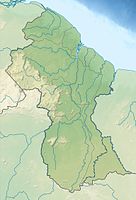Omai opencast mine
| Open pit granny | |||
|---|---|---|---|
| General information about the mine | |||
| Mining technology | Open pit | ||
| Funding / total | 6 million ounces / 186 t | ||
| Information about the mining company | |||
| Operating company | Mahdia Gold Corp. | ||
| Start of operation | 1896/1993 | ||
| Funded raw materials | |||
| Degradation of | gold | ||
| Geographical location | |||
| Coordinates | 5 ° 25 '49.9 " N , 58 ° 45' 45.6" W | ||
|
|||
| region | Cuyuni-Mazaruni | ||
| Country | Guyana | ||
The Omai open pit mine is a Guyanese gold mine in the Cuyuni-Mazaruni region . In the 1990s it was the second largest gold mine in South America. Meanwhile, the largest gold producers in South America are Peru (140 t / year), Brazil (80 t / year) and Chile (46 t / year). Guyana ranks fourth with 12 t / year.
history
The first gold mining began in 1896. Opencast mining has been carried out on a large scale and with modern technology since 1993. The annual production is about 345,000 ounces (equivalent to 10.7 t) gold. Between 1993 and the temporary shutdown in 2005, 4 million ounces of gold were produced. In 2011 the pit was bought by the mining company Mahdia Gold Corp. taken over and operations resumed.
processing
The gold is leached from the ore with cyanide , which creates large amounts of waste water and sludge that are contaminated with hydrogen cyanide and its salts ( cyanides ). Typically 13,000 tons of ore are leached per day.
Dam break in 1995
The sludge settling and storage basin for the wastewater is located north of the pit in a small valley, which is sealed off from the Omai River by an earth dike. After two years of operation, this dam broke on August 20, 1995 and 2.5 million cubic meters of cyanide-containing wastewater entered the Omai. An emergency excavation of a canal between the sewage basin and the main opencast mine, which was started immediately, ensured that another 1.2 million cubic meters of sewage did not get into the river, but instead flowed into the active open-cast mine.
A new coffer dam was built within 4.5 days so that no further pollution of the grandma took place. The poisonous wastewater ended up in the Essequibo from Omai and finally in the Atlantic. They caused fish deaths in both rivers. After a six-month break in operations, production was resumed in early 1996.
Individual evidence
- ↑ US Geological Survey, US Department of the Interior: Minerals Yearbook 2014 , November 2016, p. 31.3. Online (PDF), accessed March 19, 2017.
- ↑ Report by Mahdia Gold Corp. on the history of the mine. Online ( Memento of the original from March 20, 2017 in the Internet Archive ) Info: The archive link was inserted automatically and has not yet been checked. Please check the original and archive link according to the instructions and then remove this notice. (PDF), accessed on March 19, 2017.
- ↑ NorthernMiner.com , June 1, 2011 issue, accessed March 19, 2017.
- ↑ Steven G.Vick: Failure of the Omai Tailings Dam , Geotechnical News, September 1996, Canadian Geotechnical Society, p. 34. Online (PDF), accessed March 19, 2017.
- ↑ Vasudevan Rajaram, Subijoy Dutta, Krishna Parameswaran: Sustainable Mining Practices , CRC-Press, 2005, ISBN 978-1-439-83423-7 , p. 206
- ↑ Dangerous intoxication . September 11, 1995. Retrieved March 11, 2017.
- ↑ Steven G.Vick, Failure of the Omai Tailings Dam , Geotechnical News, September 1996, Canadian Geotechnical Society, pp. 34-40. Online (PDF), accessed March 19, 2017.
